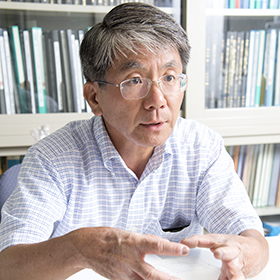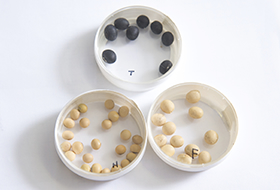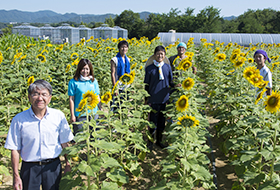 |
| |
 |
| |
|
Food is the source of life. In reality, however, food production is at risk.
|
| |
 |
|
“I study the development of new technologies for sustainable food production,” Professor Saneoka says at the beginning of the interview. Two main themes of his study are “research for breeding plants that can be grown even in poor soil” and “development of agricultural technology to deal with the depletion of phosphate reserves.”
Professor Saneoka continues, “As for the former theme, salt accumulation, drying, etc. have been making an increasing area of land poorer around the world. Now about 67% of the world’s arable land is unsuited for food production. I think that if it is possible in the future to grow crop plants even in poor land, it will help realize sustainable food production and supply. So I am conducting a study to cultivate plants that are highly resistant and can be grown even in poor soil. And these days I have particularly focused on the latter theme.” |
|
| |
“Various nutrients such as nitrogen, Phosphorus and potassium are essential for crop growth. However, if Phosphorus, an underground resource, continues to be consumed at the current rate, it will be exhausted in 50 to 100 years, just like petroleum oil. Once it is exhausted, food production will be in a crisis. Meanwhile, growing demand for fertilizers caused by the rising global population and newly emerging countries’ economic development has sparked fierce competition for phosphate reserves. So an increasing number of researchers around the world, including our team, have begun studying technologies for making more effective use of phosphate resources.”
According to Professor Saneoka, Japan is totally dependent on the import of phosphate. If Japan cannot import phosphate, it is expected that its agriculture will suffer catastrophic damage.
|
|
 |
| Professor Saneoka began research into phosphorus around 2000, when he studied as a visiting fellow in the U.S. and had a discussion with an American scientist. “The scientist said to me, ‘In the U.S., a large amount of phosphate excretion from farm animals such as pigs and poultry has become a problem, from the viewpoint of environmental contamination and resource depletion. So researchers have begun exploring ways of addressing the problem,’” Professor Saneoka recalls. |
|
| |
|
We are working to develop low-phytate grain, for the purpose of helping save phosphate reserves.
|
| |
 |
|
After returning Japan, Professor Saneoka investigated whether research had been done on this theme in Japan and found out that almost none had. So he decided to undertake research on this theme. First he focused on phytic acid, a phosphate compound. “I thought that effective utilization of phosphorus could be realized by feeding farm animals with grain low in phytic acid and rich in available phosphorus, which is easily absorbed into farm animals,” he says.
Conventional grains, raw material for livestock feeds, are high in phytic acid. Since monogastric animals such as pigs and poultry cannot break down phytic acid to use it, much of the phosphorus taken into the body is excreted. The excreted phosphorus accumulated in the soil of agricultural land causes environmental pollution. |
Professor Saneoka adds, “a nutrient element related to bone building and energy metabolism, phosphorus is essential to animals. With farm animals, a lack of phosphoric acid can lead to low productivity. Then, inorganic-phosphorus made from phosphate rock, which can be easily be absorbed by farm animals, is incorporated in livestock feed. I think this is a waste of phosphate reserves.” |
|
| |
To reduce such waste, Professor Saneoka’s team began working to develop varieties of grain crops low in phytic acid and rich in available phosphorus.
“If varieties of grains containing easily absorbed forms of phosphorus are developed, it will eliminate the need for adding inorganic-phosphate to feed, leading to savings of phosphoric reserves.” In 2004, his team started with breeding dozens of different varieties of soybeans. After they repeated the hybridization and selection process, they succeeded in obtaining varieties of soybeans low in phytic acid, more productive and more resistant to disease.
“Using these varieties of soybeans as livestock feed will save phosphorus by 50 to 60%. We are the only team in Japan that has succeeded in obtaining varieties of low-phytate soybeans. We are conducting truly advanced research. Now we are considering the registration of varieties to make our findings available to general farmers.” |
|
 |
|
| |
|
Low-phytate grain crops will contribute to protection of the environment and nutritional improvement. We are aiming to establish new agricultural technologies.
|
| |
|


|
|
“So far it has been confirmed that even if phytic acid is reduced, no changes are seen in nutrient components required for the early growth phase of grain, including germination. The reason why grain crops generally have so much phytic acid is still unknown. What part phytic acid plays remains to be explained,” Professor Saneoka says.
In addition to tests with chickens, Professor Saneoka’s team conducts experimental tests to grow vegetables by using composted manure of chickens fed with low-phytate grain. Phytic acid also has an inhibitory effect on mineral absorption. In developing countries in Africa and Central and South America, people, especially infants and young children, often have a zinc deficiency, because they regularly eat corn and wheat flour, which contains phytic acid that blocks absorption of minerals.
With low-phytate grains, zinc deficiency will be corrected. Professor Saneoka says, “The best part of the research I have been working on is to benefit people around the world by developing new plants. Agricultural technologies are considered to be established only after they are used on production sites by farmers. Our greatest goal is to establish environmentally friendly and phosphate resource-saving agricultural production.” |
Recalling the encounter with phytic acid, Professor Saneoka often tells students, “If I had not had a talk with the scientist in the U.S., I wouldn’t have undertaken this research. I hope you all will interact with various people and experience much on the farm. I also hope you will always study with an awareness of various problems.” |
|
| |
| Hirofumi Saneoka |
Professor
Plant Nutritional Physiology Laboratory
Apr. 1982: Teacher at Hiroshima Prefectural Shobara Agriculture High School
Apr. 1983: Teaching assistant at School of Applied Biological Science, Hiroshima Univ.
Feb. 1991: Assistant professor at School of Applied Biological Science, Hiroshima Univ.
Apr. 2002: Associate professor at School of Applied Biological Science, Hiroshima Univ.
Mar. 2009: Professor at School of Applied Biological Science, Hiroshima Univ.
Posted on Jan 27, 2014
|
| |








